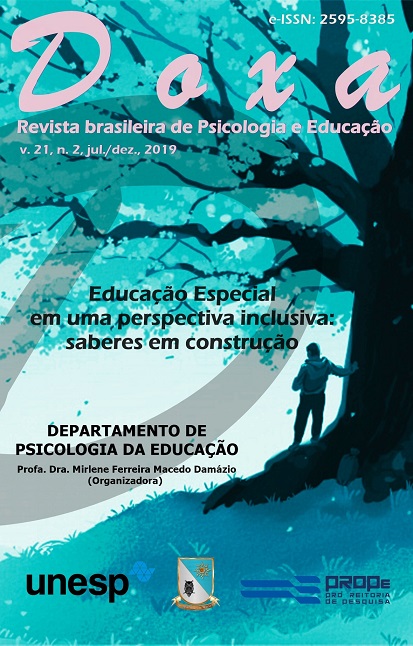Neurociência na educação especial: dos neuromitos às práticas pedagógicas baseadas em evidências
DOI :
https://doi.org/10.30715/doxa.v21i2.13101Mots-clés :
Neurociência, Educação, Educação especial, Atendimento Educacional Especializado.Résumé
O presente documento tem por objetivo apresentar uma discussão sobre as fundamentações lógica e teórica que subsidiam a disciplina de neurociência do curso de Especialização em Educação Especial da Faculdade de Educação/UFGD. A neurociência tem avançado de forma importante nos conhecimentos relacionados à educação e educação especial. No entanto, profissionais da área da educação têm dificuldades na interpretação e utilização desses conhecimentos nas práticas pedagógicas. Verifica-se que professores apresentam prevalência na crença de neuromitos, prejudicando suas práticas educacionais. Portanto, objetiva-se com a disciplina de neurociência a desconstrução de neuromitos e aprendizado das estruturas e funções neuroanatômicas e seus processos subjacentes nos diferentes níveis de análise da neurociência pelos alunos. Relacionando e discutindo os princípios aprendidos com a Educação Especial e o Atendimento Educacional Especializado.Téléchargements
Références
ANSARI, D.; COCH, D.; DE SMEDT, B. Connecting education and cognitive neuroscience: where will the journey take us? Educational Philosophy and Theory, v. 43, n. 1, p. 37-42, 2011.
BEAR, M. F.; CONNORS, B. W.; PARADISO, M. A. Neuroscience: exploring the brain. 3rd. ed. Philadelphia: Lippincott Williams & Wilkins, 2007.
BRASIL. Decreto n.º 7.611, de 17 de novembro de 2011. Presidência da República, Brasília, 2011.
BRÜHL, A. B.; SAHAKIAN, B. J. Drugs, games, and devices for enhancing cognition: implications for work and society. Annals of the New York Academy of Sciences, v. 1369, n. 1, p. 195-217, 2016.
CIONI, G.; INGUAGGIATO, E.; SGANDURRA, G. Early intervention in neurodevelopmental disorders: underlying neural mechanisms. Developmental Medicine & Child Neurology, v. 58, p. 61-66, 2016.
DE LANGE, A.-M. G. et al. The temporal dynamics of brain plasticity in aging. Cerebral Cortex, v. 28, n. 5, p. 1857-1865, 2018.
DEKKER, S. et al. Neuromyths in education: prevalence and predictors of misconceptions among teachers. Frontiers in Psychology, v. 3, p. 429, 2012.
DRAGANSKI, B. et al. Neuroplasticity: changes in grey matter induced by training. Nature, v. 427, n. 6.972, p. 311, 2004.
DUMONTHEIL, I. Adolescent brain development. Current Opinion in Behavioral Sciences, v. 10, p. 39-44, 2016.
DUZEL, E.; VAN PRAAG, H.; SENDTNER, M. Can physical exercise in old age improve memory and hippocampal function? Brain, v. 139, n. 3, p. 662-673, 2016.
GEORGIEFF, M. K.; BRUNETTE, K. E.; TRAN, P. V. Early life nutrition and neural plasticity. Development and Psychopathology, v. 27, n. 2, p. 411-423, 2015.
GLEICHGERRCHT, E. et al. Educational neuromyths among teachers in Latin America. Mind, Brain, and Education, v. 9, n. 3, p. 170-178, 2015.
GOSWAMI, U. Neuroscience and education: from research to practice? Nature Reviews Neuroscience, v. 7, n. 5, p. 406, 2006.
GROSSI, M. G. R.; LOPES, A. M.; COUTO, P. A. A neurociência na formação de professores: um estudo da realidade brasileira. Revista da FAEEBA – Educação e Contemporaneidade, v. 23, n. 41, 2014.
HALE, J. et al. Critical issues in response-to-intervention, comprehensive evaluation, and specific learning disabilities identification and intervention: An expert white paper consensus. Learning Disability Quarterly, v. 33, n. 3, p. 223-236, 2010.
HALE, J. B. et al. Reconciling individual differences with collective needs: the juxtaposition of sociopolitical and neuroscience perspectives on remediation and compensation of student skill deficits. Trends in Neuroscience and Education, v. 5, n. 2, p. 41-51, 2016.
HERCULANO-HOUZEL, S. Do you know your brain? A survey on public neuroscience literacy at the closing of the decade of the brain. The Neuroscientist, v. 8, n. 2, p. 98-110, 2002.
HIDI, S. Revisiting the role of rewards in motivation and learning: implications of neuroscientific research. Educational Psychology Review, v. 28, n. 1, p. 61-93, 2016.
HOWARD-JONES, P. A. Neuroscience and education: myths and messages. Nature Reviews Neuroscience, v. 15, n. 12, p. 817, 2014.
KRAUSE, A. J. et al. The sleep-deprived human brain. Nature Reviews Neuroscience, v. 18, n. 7, p. 404, 2017.
LINDENBERGER, U.; WENGER, E.; LÖVDÉN, M. Towards a stronger science of human plasticity. Nat. Rev. Neurosci, v. 18, p. 261-262, 2017.
LOPEZ, R. B. et al. A balance of activity in brain control and reward systems predicts self-regulatory outcomes. Social Cognitive and Affective Neuroscience, v. 12, n. 5, p. 832-838, 2017.
MARVIN, C. B.; SHOHAMY, D. Curiosity and reward: valence predicts choice and information prediction errors enhance learning. Journal of Experimental Psychology: General, v. 145, n. 3, p. 266, 2016.
OLSON, R. K. Genes, environment, and reading disabilities. In: ______ (Ed.). OLSON, R. K.Perspectives on learning disabilities. Abingdon: Routledge, 2018. p. 3-21.
PAPADATOU-PASTOU, M.; HALIOU, E.; VLACHOS, F. Brain knowledge and the prevalence of neuromyths among prospective teachers in Greece. Frontiers in Psychology, v. 8, p. 804, 2017.
RACINE, E. et al. Contemporary neuroscience in the media. Social Science & Medicine, v. 71, n. 4, p. 725-733, 2010.
RAVER, C. C.; BLAIR, C. Neuroscientific insights: attention, working memory, and inhibitory control. The Future of Children, v. 26, n. 2, p. 95-118, 2016.
ROYAL SOCIETY. Brain Waves Module 2: Neuroscience: implications for education and lifelong learning. London: The Royal Society, 2011.
THOMAS, M. S. Essay review: limits on plasticity. Journal of Cognition and Development, v. 4, n. 1, p. 99-125, 2003.
UNIVERSIDADE FEDERAL DA GRANDE DOURADOS. Especialização em Educação Especial. 2019. Disponível em: https://portal.ufgd.edu.br/pos-graduacao/educacao-especial/index. Acesso em: 15 jan. 2019.
VON STUMM, S.; PLOMIN, R. Monozygotic twin differences in school performance are stable and systematic. Developmental Science, v. 21, n. 6, p. e12694, 2018.
WILSON, R. et al. Educational attainment and cognitive decline in old age. Neurology, v. 72, n. 5, p. 460-465, 2009.
ZAHODNE, L. B.; STERN, Y.; MANLY, J. J. Differing effects of education on cognitive decline in diverse elders with low versus high educational attainment. Neuropsychology, v. 29, n. 4, p. 649, 2015.










